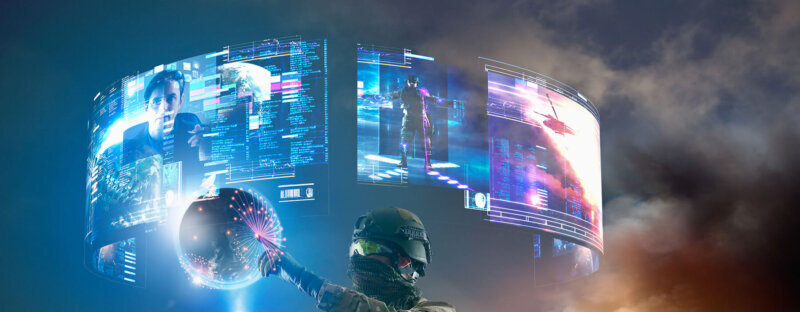Dr. Steven P. Bucci
Independent Security Consultant
Steven P. Bucci, who served America for three decades as an Army Special Forces officer and top Pentagon official, is now a Visiting Fellow as well as primary instructor in leadership for a major Washington, D.C. think tank, The Heritage Foundation. Since moving to Michigan full time, he has been working for various consulting firms both domestically and internationally covering issues related to cyber security, terrorism, and related subjects.
Bucci previously was a lead consultant to IBM on cyber security policy. He is a sought-after speaker at conferences on Cyber Security, Terrorism, National Security, Community Security, and Leadership. He provides leadership classes to corporate groups, and individual Leadership Coaching to executives. He also works to plan for and train security teams for non-profits.
As commander of 3rd Battalion, 5th Special Forces, Bucci led deployments to eastern Africa, South Asia and the Persian Gulf — including Operation Desert Thunder in 1998 in response to Saddam Hussein’s threats to violate the no-fly zone over Iraq. He also oversaw America’s first use of over the horizon drone technology while the Defense Attaché in Tirana, Albania. Bucci also served as the Defense Attaché in Sarajevo, Bosnia Herzegovina. He was already a seasoned leader in the 82nd Airborne as well as 5th & 7th Special Forces when, in July 2001, he assumed the duties of military assistant to Defense Secretary Donald H. Rumsfeld.
Little over nine weeks later, Bucci witnessed the 9/11 terrorist attack on the Pentagon. He worked directly for Rumsfeld daily for five and a half years. He retired from the Army in 2005 with the rank of colonel and stayed on at the Pentagon continuing to serve the Defense Secretary as the SES Staff Director of the Immediate Office of the Secretary of Defense, and then as civilian appointee as a Deputy Assistant Secretary of Defense.
Bucci, who grew up in Dobbs Ferry, N.Y., graduated in 1977 from the U. S. Military Academy at West Point with a Bachelor of Science degree in national security. He received his master’s and doctorate degrees in international relations in 1986 and 1987 from the University of South Carolina. He also is a graduate of the U.S. Army War College, the Hellenic Army War College in Greece and the Senior Seminar of the Department of State.
In Bucci’s assignment as Staff Director, he managed the front office of the Pentagon, and was responsible for scheduling, security, protocol, and travel, as well as most personnel issues. As Deputy Assistant Secretary of Defense for Homeland Defense and Defense Support to Civil Authorities, he responsible for overseeing policy issues involving the Defense Domains (air, land, maritime and cyber), National Guard domestic operational issues, domestic counterterrorism, readiness exercises and response to natural and manmade disasters.
Beginning in late 2008, as a part of IBM’s Public Sector Services Team, Bucci was a top strategist in the global computer giant’s cyber security campaign, his advice sought by several major federal departments. He has also served on ministry level consulting teams in the Kingdom of Saudi Arabia.
Bucci is an adjunct professor of leadership at George Mason University’ School of Engineering and previously was an associate professor of terrorism studies and cyber security policy at Long Island University.
Bucci and his wife, Suzanne, currently reside in Harbor Springs, MI, and returns to Washington, D.C. as needed. They have two grown sons — one a clinical director and psychologist, the other a former Army captain and civil servant in the Department of Homeland Security, two lovely daughters-in-law, and four grandchildren.


Articles By Steven P. Bucci
Independent Consultant and Visiting Research Fellow for Special Operations and Counter Terrorism at The Heritage Foundation.
A Great New Technology
June 17, 2017
All this may sound too good to be true, but it is real. In third-world countries the effects of a large storm can change the face of society for decades. The effect of the earthquake in Japan that wrecked the nuclear plant will be felt for generations. Hurricane Katrina changed the city of New Orleans forever. In each case, the forces of nature couldn’t be stopped, but information provided in the form of a warning could have drastically changed the final effects. Providing this warning by efficiently extracting the information that nature is whispering on low-frequency magnetic fields is the purpose of the NIMBUS technology being developed by Entropy Technology Design, Inc. near Orlando, the lightning capitol of the U.S. The insights gained by this approach have the potential to change the way the world reacts to almost every form of natural disaster.
As you would expect, different events in nature produce different magnetic signatures. Since many natural events are complicated and rapidly changing, their signatures can shift in frequency and form as they evolve in real-time. Weather events such as thunderstorms are near-chaotic systems that shift and evolve by the second over the course of their formation on time-scales that vary according to their lifetimes in the real world. A thunderstorm is a real-world event with a lifetime measured in hours. A tornado is a subset of that event with a lifetime measured in minutes. A single lightning stroke has a lifetime measured in milliseconds. And all of these events in nature transmit critical information about their formation on the magnetic spectrum. On a larger scale, events such as solar storms and earthquakes live in timeframes much longer, and so the corresponding magnetic signatures are typically of different frequencies and duration. But they are there, and are best detected and analyzed using extremely local data that is then integrated on a larger scale in the real world. This is science that is already working, not some pie in the sky “concept”, it is just waiting to be tuned and applied.
If it went no further than this, it would a major disruptor of the normal threats facing our communities and the leaders responsible for them, but there is more. Everyone thinks of drones as a U.S. “Big Military” asset that is only weaponized by America and our closest allies. Unfortunately that is no longer true. Other countries and even non-state actors like terror groups overseas and at home need only look at Amazon’s efforts to use drones to deliver books, birthday gifts, even pizza to realize they can use them to attack targets, both people and facilities. ISIS is already doing this. I recently gave a presentation to a large audience of international business leaders detailing the threat to their operations presented by small remotely piloted aircraft. At the time I had no real solution to offer other than humans with binoculars. Given the small size of these devices makes them nearly invisible to the eye until it is too late to react, this was cold comfort to those leaders. These were men and women who have invested millions of dollars in facilities, and the means to protect them, only to face the possibility of an intruder flying a drone right over their expensive security preparations to do damage of incalculable magnitude. NIMBUS technology can provide detection miles from the target.
Having been a military commander, the idea that someone could shoot a mortar, one of the most simple and effective weapons in the world, a technology that is found in essentially every military or paramilitary organization on the planet, drove me crazy. A mortar (and its cousin the tactical rocket) fires from beyond the line of sight of the good guys, goes high, in an arched trajectory, and then lands lethally “near” them spewing shrapnel and death all around it. The rounds fly quietly until their deadly landing. The best mitigator of their effect is a little bit of warning so the intended targets can get on the ground and minimize the effects of the blast. Again, this technology can provide that warning, allowing evasive action.
What does this mean? What is the bottom line?
Utilizing the NIMBUS devices with the tuning now calculated, Communities can have affordable extreme weather detection in the hands of the local first responders in time to actually do something to protect their citizens. Businesses can get the same weather related benefits, and additionally achieve drone awareness / detection that can be used by already exiting security personnel with a minimum of added training, and next to no new infrastructure that can be tailored to the threat profile of the facility. Lastly, the military / government can get all of the above plus an ability to have every Soldier / Marine carry a chip in their uniforms that continuously provides enough warning so that they never need to be hit by a mortar round again while standing upright. This will not eliminate all casualties from indirect fire attacks, but would go a long way towards reducing both their number and severity.
The bottom line is that NIMBUS, tuned to the frequencies of the threats facing each different user base would put radically improved protection / preparation ability in the hands of those that need it. It would do it BOTH more effectively and exponentially less expensively that any existing technology available. When something new can do “it” better, or cheaper, that is good. When that new thing can improve in both ways, it is exceptional.
This Technology Could Help Avert Electricity Crises Like Puerto Rico’s After Hurricane Maria
July 11, 2018
New ideas are needed to better protect our overall critical infrastructure systems and to repair it more quickly when it does get hit.
The devastation wrought by storms is always a tragedy, but in some cases it is catastrophic. A regular thunderstorm can knock out dozens to hundreds of transformers.
Nimbus may have been a cool, added safety device before, but this wider application is absolutely needed today.
As major storms and potential terrorism have made America aware of the vulnerability and critical nature of our electric infrastructure (think Puerto Rico post-Hurricane Maria), new ideas are needed to better protect this essential part of our overall critical infrastructure systems and to repair it more quickly when it does get hit.
Awhile back, I wrote about a technology that could detect incoming lightning strikes with enough warning time to get exposed people to safety.
The Nimbus technology detects very low frequency magnetic signals that are generated by thunderstorms, hurricanes, and other severe weather.
In its basic form, the Nimbus 4D handheld detector could allow attendees of outside public events (ballgames, camps, concerts, etc.) to be moved to shelter before anyone was hurt.
Applied in different forms and to larger scales, the Nimbus technology could enhance our ability to detect and provide critical warning about thunderstorms, tornadoes, and hurricanes. The same base technology also could be modified to “see” small drones approaching facilities with possible hostile intent, with enough time to take counter measures.
All this remains on the cutting edge, but many experts contacted me (and Entropy Technology Design, the designers of Nimbus) and said, “Great stuff, but it is still a ‘nice-to-have’ tech capability.” But memorably heavy storms in recent years may enable this technology to make the leap to the status of a necessity.
The devastation wrought by big storms is always a tragedy, but in some cases it is catastrophic. A regular thunderstorm can knock out dozens to hundreds of neighborhood electrical transformers. Bigger storms (hurricanes, tornadoes, squall lines) can take that number into the thousands. The island of Puerto Rico lost nearly everything.
What if the good guys could “read” the storms before they hit and were able to power down the transformers (and other electric transmission infrastructure) in the likely target area? What if they could do it seconds before the storm hits and causes an electronic surge or flips their fuses? The transformers then could be turned back on without problem as soon as the storm passes.
And what about the transformers that do get hit and damaged?
You can use the same technology to locate the specific transformers that need physical repair versus mere reset. A huge portion of the recovery time after a major storm is spent in going from transformer to transformer to see which are broken and which just need their fuses flipped.
This may sound like wishful thinking, but it actually is achievable today and Entropy also is focused on this.
Infrastructure mapping has become a critical part of the development of the Internet of Things—the network of physical devices, vehicles, home appliances, and other items embedded with software, sensors, and connectivity that enables them to connect and exchange data—and the goal of smart cities.
Smart cities seek to use the Internet of Things to provide a detailed, real-time data web that can be used by the city infrastructure to make critical decisions quickly, safely, and seamlessly. The same logic that will allow your refrigerator to tell you to buy milk as you drive by the grocery store can be used to take important city equipment off-line before it’s damaged by a thunderstorm.
In both examples, the data is real and delivered exactly where it’s needed in time to make a quality-of-life decision.
But cities can’t become truly smart until the very real threat from dangerous weather is made a part of the moment-to-moment database used to make decisions.
The Nimbus technology represents one way to add this important weather data into the planning and reaction capability of a smart city. Because the Nimbus was designed to be small and portable, it’s easily mounted on commercially available drones of the sort that are owned and operated by lots of folks today. That new concept can be used in several ways that feed on each other to provide a comprehensive system.
The first step is to “map” the electric transmission infrastructure, in particular the unique “fingerprint” of the radiated magnetic field produced by the different parts of the system (major transmission line towers, normal power poles, and neighborhood transformers). There are an enormous number of miles of these systems, but by using multiple low-cost drones, this can be done fairly quickly.
Once this map of “normal” is obtained, you have a baseline heartbeat of the city, town, or infrastructure that tells what the system looks like when in normal operation. As a storm approaches, operators use the Nimbus Base Station (provides more range and thus warning) in its original mode to determine the storm’s likely specific target area and use this information to preemptively shut down key elements seconds before the hit, and to restart it as the storm passes.
This alone would limit the damage to a point far below the norm for a major event. You don’t need to shut down an entire system for hours, or lose it for weeks when you truly can limit the shutdown to seconds (perfect for critical systems) and keep the damage to a minimum.
The final piece is sending out the same drone fleet after the storm to find the specific transformers or towers that no longer “match” the baseline. This pinpoints which should be prioritized for repair, which will allow it to be accomplished with fewer repair assets and eliminate the need for checking every individual device in the effected area.
This is a classic example of the out-of-the-box thinking we need today. By using a linked technology in different manners to accomplish multiple tasks, you save money, space, and training. Can any community or power provider afford to not invest in this kind of capability?
Nimbus may have been a cool, added safety device before, but this wider application is absolutely needed today. No one could have foreseen how brittle the critical infrastructure of Puerto Rico had become. Hurricane Maria simply destroyed it.
The American people have stated clearly they think the recovery operation is too slow, despite the Herculean efforts being made. We must do better as a society, and the goals and visions of the Internet of Things and smart cities as a driver can help us accomplish this.
Today there is a choice. Deployment of technologies such as Nimbus can map our infrastructure systems, identify a storm’s target, guide mitigating actions to minimize damage (and downtime), and finally triage the recovery effort. Every step gets citizens back up and on the grid faster and more effectively.
All together, this means less suffering and less cost. The investment is small compared to the savings.
Why are we waiting?
This piece originally appeared in the Daily Signal.






